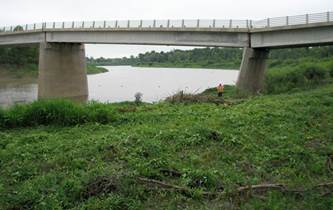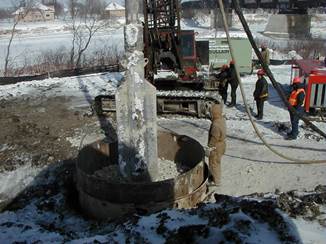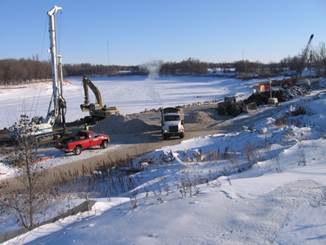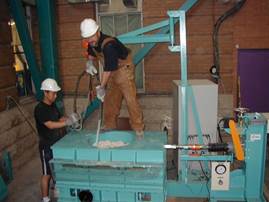

The research examines the impacts of both mechanical and environmental loading on geosynthetic-reinforced soil slopes using fine-grained fills such as clays and silts. The mechanical loading is in the form of externally applied stresses and the environmental loading in the form of wetting and drying of clays and freezing and thawing of silts. A large-scale model test device was built and commissioned for testing reinforced soil specimens subjected to mechanical and environmental loadings. Numerical models for slopes reinforced with geosynthetics were developed for applications to highway embankments and bridge interchanges, particularly in the cold climates and expansive soils such as those found frequently in western and northern Canada.




This research evaluates how rockfill columns could stabilize riverbanks. Conventional laboratory tests, large-scale laboratory direct shear tests, full-scale field tests, and numerical modeling were performed. The design methods developed are now being used by consulting engineers to safely and economically stabilize riverbanks, the expanded Winnipeg Floodway, and bridge approaches.






This research project studies possible causes of instabilities at Seven Sisters Generating Station on the Winnipeg River. The project investigated why some dyke sections became unstable while others remained stable. The investigation included a laboratory testing program, numerical modeling, and chemical investigation of the foundation soil. Based on this investigation, it appears likely that the dykes at Seven Sisters had been stable for over fifty years only because of a microstructure in the foundation that originally contained cementation bonding. Changes in soil chemistry, resulting from leaching of cementation bonds produced by seepage under the dykes, caused changes in brittleness and anisotropy and triggered instabilities of the dykes. The results of the study have been used by Manitoba Hydro as part of its dam safety evaluation procedures for risk management.



A study has been carried out on the thermal performance of degrading permafrost beneath road embankments and foundations of electrical transmission towers impacted by climate changes and construction activities. Impacts of climate warming to highway embankments on degrading permafrost and adaptation strategies have been evaluated. Laboratory tests are being carried out and fully-instrumented sections of the test site are being monitored. Development of a viscoplastic clay model that incorporates the effects of temperature is underway.




This research investigates the performance of highway embankments on peat deposits. Canada has more peat lands than any other country in the world, covering 18% of the land area, primarily in northern areas of the country. In northern Manitoba, hundreds of kilometers of roads are built over muskeg or peat terrain. Two construction methods were evaluated: winter and summer constructions. Test sections for new highway construction with and without corduroy have been instrumented.






Hudson Bay Railway is an important part of the trade network that connects northern Canada to North America and the rest of the world. It is the only freight and land transportation connection to many northern communities. Additional shipping to and from northern Canada can be expected due to thawing of summer ice in the Arctic Ocean. Maintaining the railroad has been a challenge ever since the lines were opened. However, over the last five to seven years the line experienced more frequent and active development of subgrade failures, heaves, and other similar problems adversely affecting the operation of the railway. To enhance the reliability and sustainability of the railway infrastructure, research is undertaken to identify the locations where the rail embankment reduces its ability to support the rail structure, evaluate the magnitude of the problem, and then determine potential repair technique to correct the problem.



